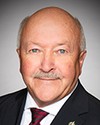Thank you, Chair.
Welcome to our witnesses today. It's good to have some of you back, those we've seen at previous meetings.
I want to focus on coastal erosion and disaster mitigation funding. I live in a very rural, remote community. I guess I could call it “remote” or “rural”. Bonavista—Burin—Trinity has 256 small communities, for the most part, that rely heavily on the infrastructure program that we support as a government.
Since 2015 we have had 221 infrastructure projects that have been approved, which is pretty impressive in terms of the numbers, but these are not large-dollar-value projects. Many of them are very small, but they provide very important support to these small communities.
Many of these communities have challenges besides rural infrastructure, like the normal stuff you see: bridges, roads and municipal stuff. With coastal erosion, we have had numerous storms that have come up the eastern seaboard, in the fall of the year especially, that do tremendous damage to coastal infrastructure. Many of them have seawalls that were constructed 50 years ago that need replacement, places like Bonavista, for example.
On the Burin Peninsula, there are a number of communities where they have erosion taking place on some of their coastline, which impacts some of the roads that run next to it. It's a beautiful riding to drive around because you're always looking at the ocean, for the most part, if you're travelling the peninsulas—the Burin Peninsula, the Bonavista Peninsula, the Baie Verte Peninsula and so on.
These are major challenges, because doing these projects is very expensive. In terms of the percentage of costs, many of these small communities are really challenged to able to do these projects.
You mentioned earlier, Ms. Gillis, that these communities and municipalities can now apply directly to Infrastructure Canada to secure funding to try to fix some of these problems. Many of them, as I said, run into millions of dollars.
What percentage of the funding would the community have to provide, number one? Number two, if we encourage our towns to apply, what is the process they have to go through? Basically, how do they access that funding?
Thanks.

